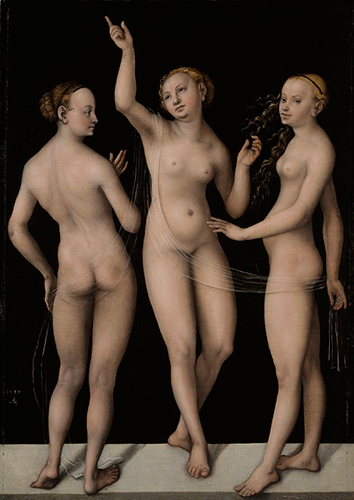Comparing, Contrasting Female Nudes of German Renaissance
Kansas City, MO. Sept. 30, 2020 – The pursuit of the “ideal” female body was as much a preoccupation in Renaissance Germany as it is today. Like the filtered photographs we encounter today in magazines and social media posts, images of idealized women in various stages of undress also proliferated during the 15th and 16th centuries. The exhibition Perfectly Imperfect: Cranach, Dürer and the Renaissance Nude compares and contrasts the female nudes of the two most important artists of the German Renaissance. This is the museum’s first exhibition featuring German Renaissance paintings in 60 years.
“Today we find beauty in all shapes and sizes, and we seek a healthy mindset that is based on feeling comfortable in our own bodies,” said Julián Zugazagoitia, Menefee D. and Mary Louise Blackwell CEO & Director of the Nelson-Atkins. “During their time, both Lucas Cranach the Elder and Albrecht Durer shared a life-long fascination with the female form and held radically different approaches to the subject. Yet the standards of beauty are always evolving, and we see beauty today in a less canonical, less formulaic way.”
The exhibition features a selection of prints by Albrecht Dürer from the Nelson-Atkins, as well as a manuscript on loan from the Linda Hall Library. The works on paper demonstrate Dürer’s preoccupation with depicting the nude according to a system of precise mathematical measurements.
Central to the exhibition is The Three Graces by Lucas Cranach the Elder, one of the masterpieces of the Nelson-Atkins’ permanent collection. There are just three representations of The Three Graces in existence. One is at The Louvre in Paris and one is in a private collection in Cambridge, England. The Nelson-Atkins painting is the only one in the U.S.
“Our painting is a perfect example of the beauty formula that Cranach developed in the late 1520s,” said Rima Girnius, Associate Curator, European Painting & Sculpture. “Unlike Dürer’s proportionately correct nudes, Cranach’s nudes were impossibly sinuous with long, snaking limbs, slim hips, and high, rounded breasts.”
The painting is paired with Cranach’s representation of The Judgement of Paris, on loan from the Saint Louis Art Museum, to highlight the stylized elegance of Cranach’s nudes.
The human figure remains a popular subject for artists in the 21st century, and guests to the Nelson-Atkins are invited to contrast this Renaissance view of the human figure with a 21st-century view. A contemporary gallery in the Bloch Building features works from the 1960s to today that build on this enduring tradition: artists using the human figure to convey ideas about society, history, emotions, and identity.
Among those works are the recent acquisition Figure with Skirt, a three-dimensional work by Simone Leigh, who focuses on the black female body as a repository of strength, knowledge, and wisdom, and Vanessa German’s Glory, a vivid portrayal of a black woman, created with glitter, beads, sequins, feathers, and symbolic objects.
“At the Nelson-Atkins, we encourage visitors to see the world from many perspectives,” said Zugazagoitia. “By viewing the Renaissance works in the original Nelson-Atkins Building, then contrasting those with contemporary works in the Bloch Building, our visitors can consider the evolving view of the human body, as well as join the critical dialogue surrounding race and representation in the world of Western art history.”
Image caption: Lucas Cranach the Elder, German, 1472–1553. The Three Graces, 1535. Oil on wood panel. Purchase: William Rockhill Nelson Trust, 57-1
The Nelson-Atkins Museum of Art
The Nelson-Atkins in Kansas City is recognized nationally and internationally as one of America’s finest art museums. The museum, which strives to be the place where the power of art engages the spirit of community, opens its doors free of charge to people of all backgrounds. The museum is an institution that both challenges and comforts, that both inspires and soothes, and it is a destination for inspiration, reflection and connecting with others.
The Nelson-Atkins serves the community by providing access to its renowned collection of more than 42,000 art objects and is best known for its Asian art, European and American paintings, photography, modern sculpture, and Native American and Egyptian galleries. Housing a major art research library and the Ford Learning Center, the Museum is a key educational resource for the region. In 2017, the Nelson-Atkins celebrates the 10-year anniversary of the Bloch Building, a critically acclaimed addition to the original 1933 Nelson-Atkins Building.
The Nelson-Atkins is located at 45th and Oak Streets, Kansas City, MO. Hours are Monday, Wednesday, 10 a.m.–5 p.m.; Thursday/Friday, 10 a.m.–9 p.m.; Saturday, 10 a.m.–5 p.m.; Sunday, 10 a.m.–5 p.m. The museum is closed Tuesday. Admission to the museum is free to everyone. For museum information, phone 816.751.1ART (1278) or visit nelson-atkins.org.
For media interested in receiving further information, please contact:
Kathleen Leighton, Manager, Media Relations and Video Production
The Nelson-Atkins Museum of Art
816.751.1321
kleighton@nelson-atkins.org
